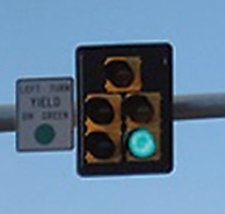Automobiles Laws and policies Safety: Driving tips
by Brian
Comments Off on DRIVING TIP #3: Wait in the intersection to turn left
DRIVING TIP #3: Wait in the intersection to turn left
 In my previous tip, I discussed not blocking intersections. Today, I’ll discuss a time when it’s okay to wait in the intersection.
In my previous tip, I discussed not blocking intersections. Today, I’ll discuss a time when it’s okay to wait in the intersection.
Sometimes you’ll come to an intersection where you want to turn left and there’s a flashing yellow arrow or a circular green signal but no green arrow at the time you want to turn. In this situation, I usually see people dutifully wait behind the stop line. Then the light turns red and they’re still sitting there. Even worse are intersections that don’t have a protected left arrow at all– I’ve seen people wait behind the line through multiple cycles because oncoming traffic is too heavy to allow them to turn. Occasionally they’ll even give up.
Instead of waiting behind the line, the best thing to do if you need to wait to turn left is to move part of the way into the intersection and wait there. Then, if the light turns red before you’re able to turn, the oncoming traffic will stop and you can complete your turn.
Legalities
How is this legal, though, when, as we discussed previously, the law (Texas Transportation Code §545.302(a)(3)) specifically prohibits stopping in an intersection? (Boy, there were a lot of commas in that sentence!) In this case, subsection (f) of that statute provides an exception “if the avoidance of conflict with other traffic is necessary.” In this case, you’re stopping to avoid conflicting with oncoming traffic, so subsection (f) allows it.
The prohibition on stopping in intersections is intended to prohibit stopping in an intersection if you’ll obstruct cross-traffic (or pedestrians) when they have a green. But if you’re just waiting to turn left, you’ll be out of the way before cross-traffic gets a green or immediately thereafter, therefore not becoming an impediment to them (unless, of course, there’s congestion on the street you want to turn onto; in that case, wait behind the line.)
But if you’re still in the intersection when the light turns red, won’t you be running a red light? No, because the law says you cannot enter an intersection when the signal is red. If you entered the intersection on a green and are still there when it’s red, you are lawfully in the intersection and other traffic must by law yield to you (§544.007 (b)).
Caveats
A cautionary note: If you’re waiting to turn left and your light turns red, make sure that the oncoming traffic is actually stopping before you turn– sometimes they’ll still have a green light even when your direction has a red. If there is a sign at the intersection that reads “ONCOMING TRAFFIC HAS EXTENDED GREEN”, this means that the signal for your direction will turn red before the oncoming traffic gets a red. In this case, it is probably safer for you to wait behind the stop line to turn left. (Note, though, that there’s not always a sign in this situation.) The flashing yellow arrow signal now being widely deployed was developed specifically to eliminate this hazardous situation known as the “yellow trap“.
Also, if you’re waiting in the intersection to turn left and the light turns red, don’t back out of the intersection! Just wait for oncoming traffic to clear and then complete your turn. Don’t worry if this means you have to wait in the intersection for a few seconds after the light has turned red– just stay calm and wait until it’s safe to turn. If anyone on the intersecting road honks at you, you can be secure in the knowledge that they’re the doofus. As discussed above, you’re not running the red light because you were already in the intersection when it turned red and that doofus is required to yield to you.
Finally, while you’re waiting to turn left, make sure your wheels are pointed straight ahead, i.e. don’t have your wheels pointed toward the left. That way, if someone rear-ends you, you won’t be propelled into oncoming traffic.
Why do this?
Waiting in the intersection to turn left is considerate to the drivers behind you and moves more traffic through the intersection during each cycle, helping to reduce congestion. Furthermore, it puts you in a position to be able to take advantage of smaller gaps in traffic because you’re already in the position to turn instead of having to traverse part of the intersection first. I’ve driven in many places where this technique is widely practiced and have seen two, three, sometimes even four cars get through when the light turns red! And at intersections with no protected left arrow, you often have to do this just to be able to turn left during peak periods. (If you’ve driven in Los Angeles, you know what I’m talking about.)
The fine print
As always, the tip above is my own layman’s opinion and is intended as general information that can’t cover every possible scenario, so always use your own best judgement. If you need legal advice, consult a lawyer as I am not a lawyer nor do I play one on TV.
- Texas Highway Man – Texas Traffic Laws – Waiting in intersections
- Powers & Taylor – Texas Traffic Law Quiz
- Defending People – PSA: The Left-Turn Yield
- Quora – In which U.S. states is it illegal for a driver to move their vehicle into the middle of an intersection during an unprotected left turn at a green traffic light?